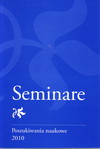Relikwie Undecim milia virginum w pocysterskim kościele w Lądzie nad Wartą i dedykowany im ołtarz-relikwiarz św. Urszuli
Undecim milia virginum relicts in the Ląd cistercian abbey upon Warta and the altar of st. Ursula dedicated to them
Author(s): Janusz NowińskiSubject(s): History
Published by: Towarzystwo Naukowe Franciszka Salezego (TNFS)
Keywords: St. Ursula; Undecim Milia Virginum; Relics; the cult of relics; Ląd upon Warta; Altenberg; altar
Summary/Abstract: In 1182, to the Cistercian abbey in Altenberg next to Cologne, many a Undecim Milia Virginum relic came from the so-called "ager Ursulanus" - the late ancient cemetery discovered in 1106 under the walls of the colony considered to be the burial place of St. Ursula, and the accompanying retinue. The abbey in Altenberg was sending Undecim Milia Virginum relicts to other Cistercian abbeys all over Europe propagating their cult amongst the convent. The cult of Undecim Milia Virginum in Ląd dates back to the very beginning of the abbey that is the 12th century. In the middle of the 13th century, Ląd got from Altenberg relicts of the virgin martyrs of Cologne which are still in the Ląd abbey. In 1721, Abbot Antoni Mikołaj Łukomski founded a monumental reliquienaltar dedicated to St. Ursula and her companions. The altar had been made in the workshop of Ernest Broger in Glogau. It is the largest of the altars dedicated to St. Ursula. The relics of skulls and bones placed at the altar are covered with embroidered fabrics dating back to the 19th century. At that time, the altar was undergoing a major renovation. The renovation of fabrics conducted in 1983 revealed that under the textiles from the 19th century the remains of Medieval and Baroque fabrics had been preserved.
Journal: Seminare. Poszukiwania naukowe
- Issue Year: 28/2010
- Issue No: 2
- Page Range: 253-272
- Page Count: 20
- Language: Polish

